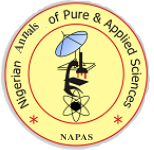Submissions
Submission Preparation Checklist
As part of the submission process, authors are required to check off their submission's compliance with all of the following items, and submissions may be returned to authors that do not adhere to these guidelines.- The submission has not been previously published, nor is it before another journal for consideration (or an explanation has been provided in Comments to the Editor).
- All Authors and Co-Authors' emails, Surnames, initials of other names, and their full addresses, the way they are expected to appear in the final published manuscript, must be provided in the appropriate spaces under metadata before final submission.
- At the final submission step, once an article has been submitted, the author will no longer be able to edit it. So, ensure all details are properly captured before clicking the final submission step.
-
The submission file is in Microsoft Word.
Where available, URLs for the references and DOI have been provided. - The text is double-spaced; uses a 12-point font Time New Romans; employs italics, rather than underlining (except with URL addresses); and all illustrations, figures, and tables are placed within the text at the appropriate points, rather than at the end.
- I have read and the text adheres to the stylistic and bibliographic requirements outlined in the Author Guidelines here: (to avoid rejection and delay processing) https://napas.org.ng/index.php/napas/guide
Privacy Statement
The names and email addresses entered in this journal site will be used exclusively for the stated purposes of this journal and will not be made available for any other purpose or to any other party.


 Contact Us
Contact Us Editorial Team
Editorial Team Join As A Reviewer
Join As A Reviewer  Request For Print Copy
Request For Print Copy


 Cprint Publishers
Cprint Publishers